Christmas is the one time of year that friends and family come together to celebrate with lots of food, colourful presents and decoration laden trees.
Issue information
Some of the first items used to decorate Christmas trees were as simple as fruit and nuts. Sprigs of holly and other seasonal flowering plants were also used, as well as candles, which were a bit of hazard until the invention of lights. As the custom of putting up a Christmas tree slowly began to spread through Europe and on to America, the ornaments became more diverse as people started experimenting with different materials.
The first tinsel was made of beaten silver and was much heavier and limited in colour compared to today’s vast array of glistening, colourful plastic and foil versions. Cookies, marzipan and other sweet treats were cut into different shapes such as circles, hearts and stars and hung on branches along with paper snowflakes and hand stitched angels.
This homemade style was overtaken in popularity when the art of glass blowing was taken up in Germany and delicate hand crafted baubles were produced. By the 1880s, Germany was leading the world in hand crafted glass ornaments. Moulds of children, angels, bells and more saw the shape and style of Christmas decorations change once again.
With the popularity of celebrating Christmas on the rise, the Christmas decoration market began to boom around the world. Soon Japan and the Czech Republic were producing decorations to be imported into America and Europe. The invention of new technology and materials meant that mass production was possible. Suddenly everybody could have glittering, colourful decorations adorning their Christmas tree.
The particular style of art that has been used to create this year’s stamps is known as quilling. It’s thought that its origins date back more than 500 years, but it was at its most popular during the late eighteenth and early nineteenth centuries. The name came from the act of wrapping a strip of paper around a feather quill to create a tight coil. These days, people can get special tools and templates as well as machine cut strips to make their artworks even more detailed and precise.
Quilling’s popularity peaked in the early 1800s as a hobby for ‘ladies of leisure’. Although previous to that it had been popular among nuns as a way of decorating sacred texts, containers and holy pictures.
Quilling has been brought back to life in recent years with many hugely talented artists such as Yulia Brodskaya who is responsible for the stamp artwork, choosing it as their discipline. A close look at the art works displayed in this stamp issue gave an idea of the time, patience and skill required to create these vibrant works.
First Day Cover
Evergreen trees have been used as a celebratory symbol for centuries. Before being adopted by Christians as a way to celebrate the birth of Jesus, pagans had used the evergreen as a symbol for celebrating life. Many ancient civilisations decorated their homes and places of worship with branches of evergreens at the end of Winter to celebrate the new life that came with the onset of Spring.
First Day Cover with Self-adhesive Stamps
With Christmas falling in Summer in our little corner of the world, we tend to have slightly different traditions from the rest of the world. The pōhutukawa has become New Zealand’s Christmas tree. Its time of bloom and bright red flowers contrasted against its deep green foliage, make it the perfect choice for decoration. Many Kiwis proudly display the deep crimson blooms over their doorways, on Christmas cards and above mantle pieces during the festive season.
Miniature Sheet First Day Cover
Each image that appeared on the Christmas stamps was created through the art of quilling. Quilling is the process of coiling thin strips of paper into a variety of shapes which come together to create a larger picture. Items like toothpicks, knitting needles and pencils can be used as a base to coil the paper around. Coils can be shaped by pinching one or both sides to create a teardrop shape. Glue is used to help the coils hold their form and to stop them from unwinding. The result is gloriously detailed, vibrant images such as those that were depicted on the Christmas stamps.
Miniature Sheet
The image on the miniature sheet showed a close up view of the quilled filaments that made up the wreath. The tight red coils that created the berries could be seen to have multiple colours in them, the detail that created a fuller looking image was taken into consideration at every turn. New Zealand Christmas colours of bright summery reds and luscious greens intermingled with strips of pale blue to keep the designs looking fresh and festive!
Product Listing for Christmas 2017
| Image | Title | Description | Price |
|---|---|---|---|
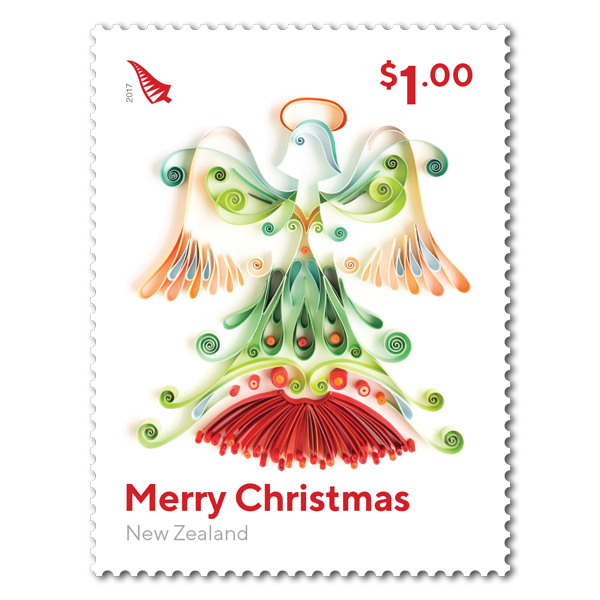 |
Single Stamp |
Single $1.00 'Angel' gummed stamp. The story of the birth of Jesus has long influenced Christmas, from carols, to stories to decorations. One of the most common Christmas decorations is the angel, which often takes pride of place at the top of the Christmas tree. Several angels appear in the Nativity story and each plays a crucial role as a messenger or guardian. As the angels often appeared hovering high above the earth keeping watch over the proceedings, this may explain why they have taken the spot atop Christmas trees. |
$1.00 |
 |
Single Stamp |
Single $2.20 'Bauble' gummed stamp. As is the case with many traditional Christmas decorations, Germany is to thank for the creation of glass baubles. Originally people would use nuts, berries and marzipan to decorate their trees. These shapes evolved into decorative glass ornaments that were crafted by hand, and as a result were only available to the wealthy. With advances in technology, cheaper versions using different materials, texture, colour and sparkle were able to be produced around the world, making them more affordable and accessible to everyone. |
$2.20 |
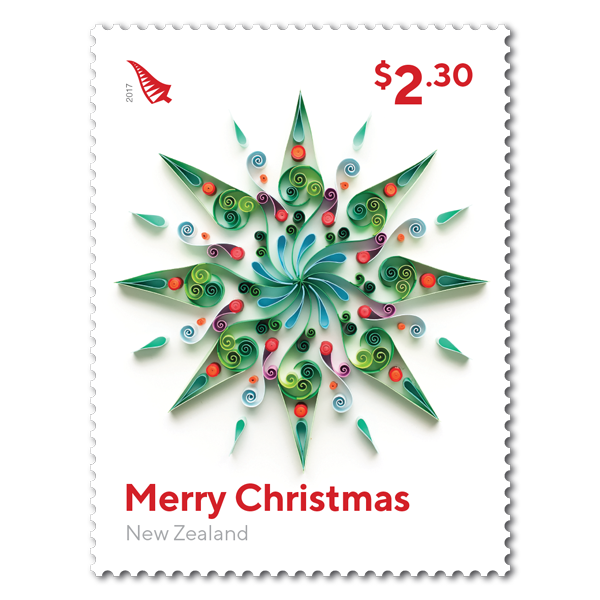 |
Single Stamp |
Single $2.30 'Star' gummed stamp. Atop of most Christmas trees you’ll find either an angel or a star. The star is another decoration that’s origins trace back to the Nativity story. At the time of the birth of Jesus, a bright shining star appeared in the sky and many flocked to the location beneath the it to worship their new lord. The star is now a popular and common decoration associated with Christmas all over the world. |
$2.30 |
 |
Single Stamp |
Single $2.70 'Bell' gummed stamp. The association of bells with Christmas has been around for a long time. Pagans used to ring bells to ward off evil spirits, while churches would ring bells to announce the beginning of mass or a wedding. Bells eventually became associated with happiness and celebration, and as a result were often rung throughout the Christmas season with merriment. They have since appeared in Christmas carols, as decorations and are a well-recognised symbol of Christmas. |
$2.70 |
 |
Single Stamp |
Single $3.30 'Wreath' gummed stamp. This is another Christmas decoration that finds its origin amongst the pagan traditions in Germany. The tradition of hanging sprigs and branches of evergreens over doorways to celebrate the coming of new life, developed into the circular, wreath shape we know today. Another theory on its origin is that it comes from the laurel crowns that were worn by royalty in ancient Greek and Roman times. |
$3.30 |
 |
Single Stamp | Single $1.00 'Angel' self-adhesive stamp. | $1.00 |
 |
Single Stamp | Single $2.20 'Bauble' self-adhesive stamp. | $2.20 |
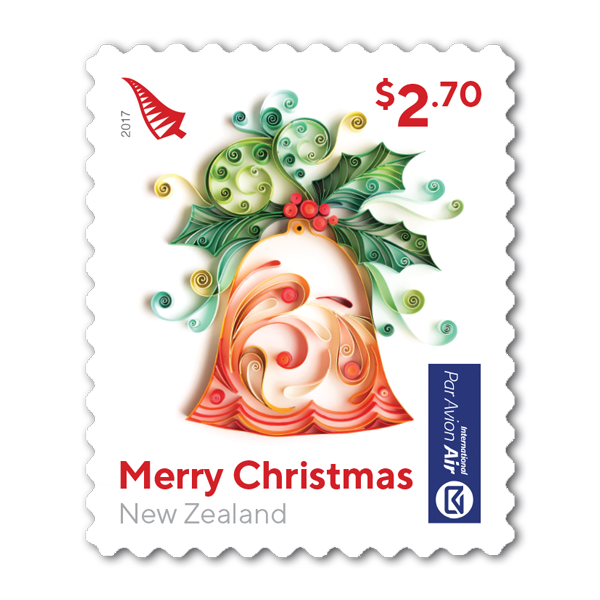 |
Single Stamp | Single $2.70 'Bell' self-adhesive stamp. | $2.20 |
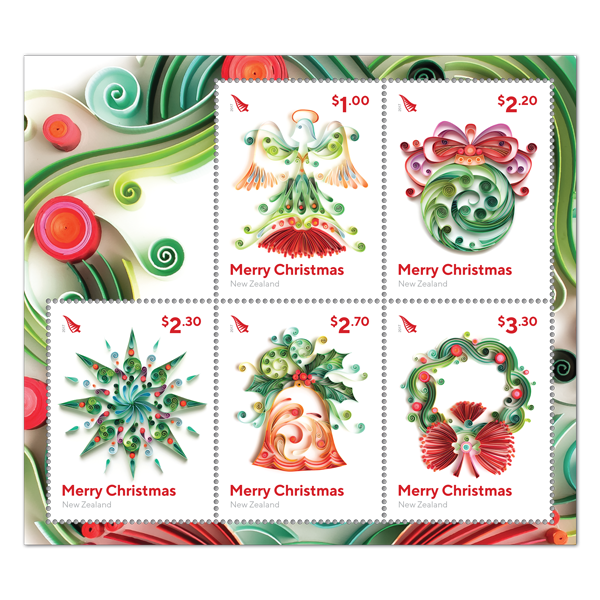 |
Miniature Sheet | Mint, used or cancelled miniature sheet. | $11.50 |
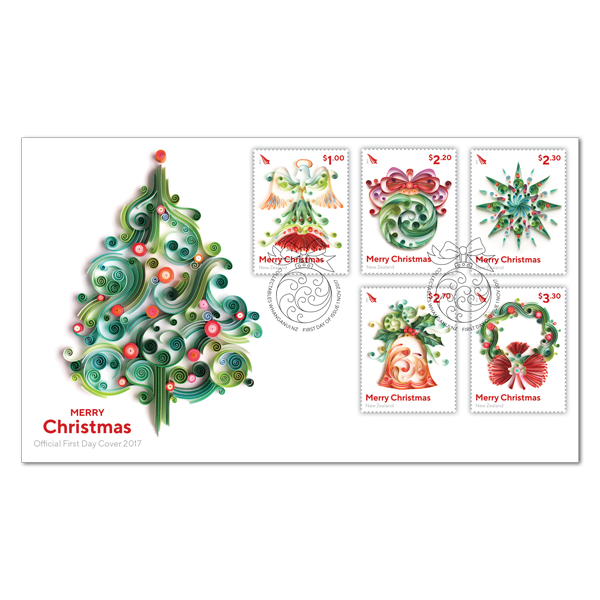 |
First Day Cover | First day cover with five gummed stamps affixed. Cancelled on the first day of issue. | $12.00 |
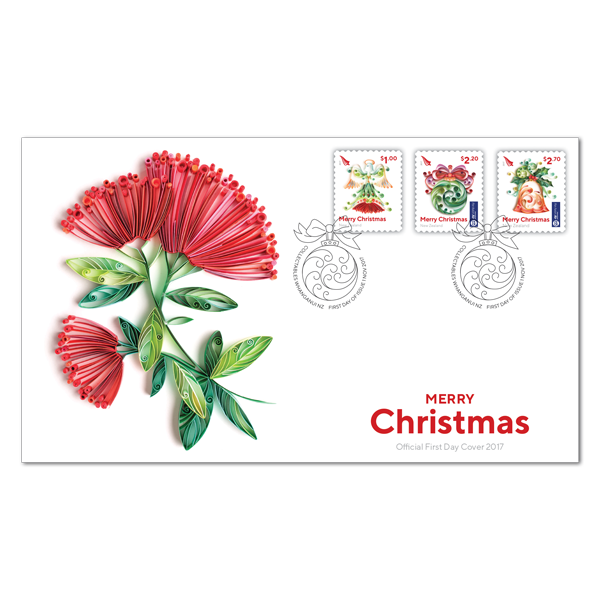 |
First Day Cover | First day cover with three self-adhesive stamps affixed. Cancelled on the first day of issue. | $6.40 |
 |
Miniature Sheet First Day Cover | First day cover with miniature sheet affixed. Cancelled on the first day of issue. | $12.00 |
 |
Self-adhesive Dispenser | Dispenser box containing 100 x $1.00 self-adhesive stamps. | $100.00 |
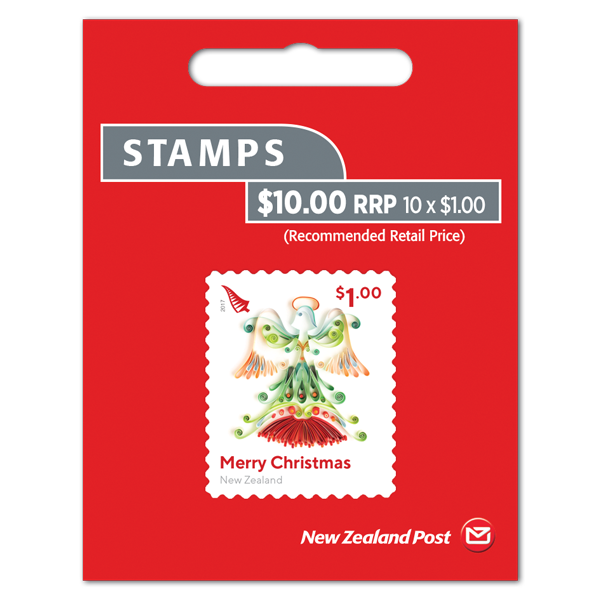 |
Self-adhesive Booklet | Booklet containing 10 x $1.00 self-adhesive stamps. | $10.00 |
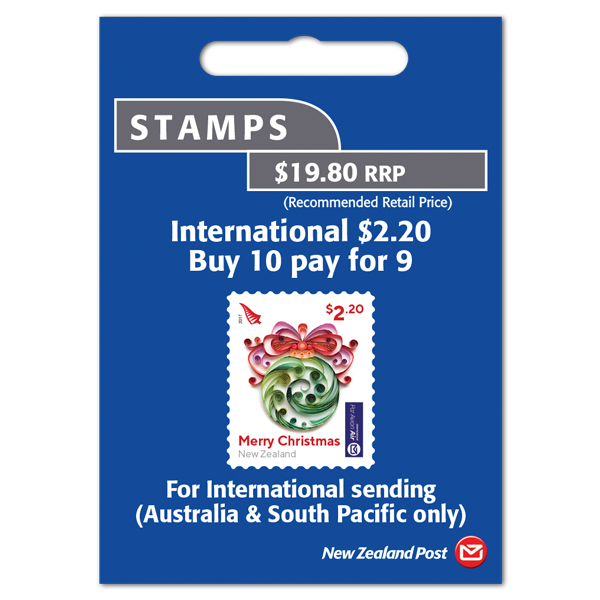 |
Self-adhesive Booklet | Booklet containing 10 x $2.20 self-adhesive stamps. | $19.80 |
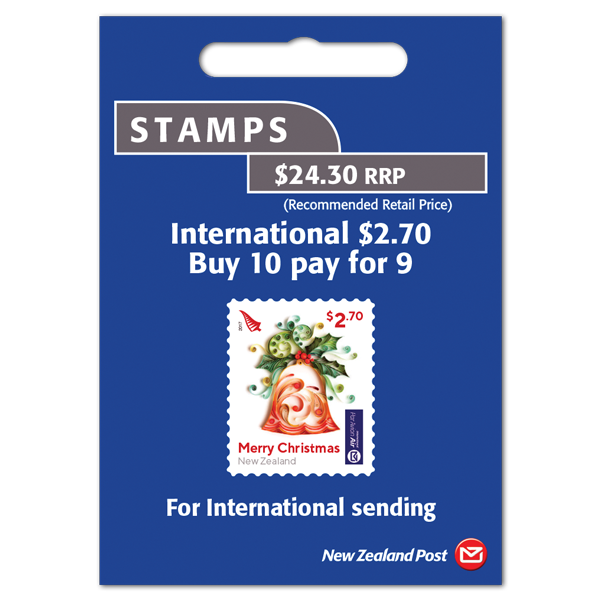 |
Self-adhesive Booklet | Booklet containing 10 x $2.70 self-adhesive stamps. | $24.30 |
Technical information
| Date of issue: | 1 November 2017 |
|---|---|
| Number of stamps: | Five gummed and three self-adhesive |
| Denominations: | Gummed: $1.00, $2.20, $2.30, $2.70 and $3.30; Self-adhesive: $1.00, $2.20 and $2.70 |
| Designed by: | Nicky Dyer, Wellignton, New Zealand; Artwork by Yulia Brodskaya |
| Printer and process: | Southern Colour Print Ltd, New Zealand by offset lithography |
| Number of colours: | Gummed: four process colours; Self-adhesive: four process colours plus red phosphor |
| Stamp size and format: | Gummed: 35mm x 46mm (vertical); Self-adhesive: 25mm x 30mm (vertical) |
| Paper type: | Gummed: Tullis Russell 104gsm red phosphor gummed stamp paper; Self-adhesive: Tullis Russell Red Phosphor PSA stamp paper |
| Number of stamps per sheet: | 25 |
| Perforation gauge: | Gummed: 14.286 x 13.895; Self-adhesive: diecut |
| Special blocks: | Plate/imprint blocks could be obtained by purchasing at least six stamps from a sheet. Barcode blocks were available in A and B formats. |
| Period of sale: | These stamps remained on sale until 31 October 2018. First day covers remained on sale until 31 December 2017. |



